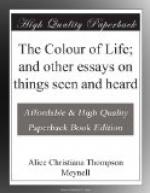So little stands between a gamin and all the dignities of Nature. They are so quickly restored. There seems to be nothing to do, but only a little thing to undo. It is like the art of Eleonora Duse. The last and most finished action of her intellect, passion, and knowledge is, as it were, the flicking away of some insignificant thing mistaken for art by other actors, some little obstacle to the way and liberty of Nature.
All the squalor is gone in a moment, kicked off with the second boot, and the child goes shouting to complete the landscape with the lacking colour of life. You are inclined to wonder that, even undressed, he still shouts with a Cockney accent. You half expect pure vowels and elastic syllables from his restoration, his spring, his slenderness, his brightness, and his glow. Old ivory and wild rose in the deepening midsummer sun, he gives his colours to his world again.
It is easy to replace man, and it will take no great time, where Nature has lapsed, to replace Nature. It is always to do, by the happily easy way of doing nothing. The grass is always ready to grow in the streets—and no streets could ask for a more charming finish than your green grass. The gasometer even must fall to pieces unless it is renewed; but the grass renews itself. There is nothing so remediable as the work of modern man—“a thought which is also,” as Mr Pecksniff said, “very soothing.” And by remediable I mean, of course, destructible. As the bathing child shuffles off his garments—they are few, and one brace suffices him—so the land might always, in reasonable time, shuffle off its yellow brick and purple slate, and all the things that collect about railway stations. A single night almost clears the air of London.
But if the colour of life looks so well in the rather sham scenery of Hyde Park, it looks brilliant and grave indeed on a real sea-coast. To have once seen it there should be enough to make a colourist. O memorable little picture! The sun was gaining colour as it neared setting, and it set not over the sea, but over the land. The sea had the dark and rather stern, but not cold, blue of that aspect—the dark and not the opal tints. The sky was also deep. Everything was very definite, without mystery, and exceedingly simple. The most luminous thing was the shining white of an edge of foam, which did not cease to be white because it was a little golden and a little rosy in the sunshine. It was still the whitest thing imaginable. And the next most luminous thing was the little child, also invested with the sun and the colour of life.
In the case of women, it is of the living and unpublished blood that the violent world has professed to be delicate and ashamed. See the curious history of the political rights of woman under the Revolution. On the scaffold she enjoyed an ungrudged share in the fortunes of party. Political life might be denied her, but that seems a trifle when you consider how generously she was permitted political death. She was to spin and cook for her citizen in the obscurity of her living hours; but to the hour of her death was granted a part in the largest interests, social, national, international. The blood wherewith she should, according to Robespierre, have blushed to be seen or heard in the tribune, was exposed in the public sight unsheltered by her veins.




